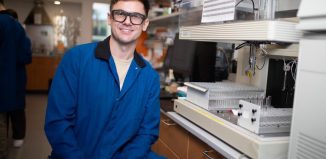Studying the effects of global warming in plants
By Daniel Dunaief
While plants don’t generally reach for a glass of milk, crouch down to stalk their prey or seek higher ground in a storm, they do respond to changes around them. They compete for sunlight, water and territory. They also have ways of turning on or off their own genes in response to stressful conditions.
Qiong Alison Liu, a principal investigator and research assistant professor at Stony Brook University, recently revealed how microRNA, which is involved in gene expression, changes in response to elevated carbon dioxide levels and higher temperatures.
These conditions are likely to continue to increase as a result of global warming.
In a research paper published in the journal Nature Communications, Liu is the “first to show greenhouse gas can function quite similarly as other stressors,” she said. “This opens up many questions.” Other greenhouse gases, like ozone, methane and nitrous oxide, could possibly have a similar impact on small RNA expression, she said.
She explored how a change of 3 to 5 degrees Celsius alters miRNA, Liu said.
While scientists have known that higher temperatures and carbon dioxide have opposite effects on plant growth, Liu showed that they have competing characteristics in miRNA.
The next step, Liu suggested, is to understand which influence is dominant.
If higher temperatures prevail, leading to photorespiration, plants may produce less biomass and become less productive. Scientists can potentially lend a hand, Liu suggested, through genetic engineering.
These altered plants can be “made to mask miRNAs effects by simply introducing mutations in miRNA target genes to block” their activity, she said.
The Stony Brook researcher cautioned, however, that such engineering, especially with economically important plant species, would need to await a better understanding of how “all the factors work together.” The information in model plants, like the Arabidopsis in Liu’s studies, could be used as a guide to study higher and more complex plants.
Liu explained that the study of miRNA is relatively new. Scientists recognized their role as biological regulators with conserved functions in the early 2000s.
The reason she took this approach relates to her indirect path to plants. From 1985 to 1987, she was enrolled in the first environmental program at Beijing University, where she studied environmental law and environmental biology and ecology.
When she worked at Cold Spring Harbor Laboratory in Michael Hengartner’s lab, she conducted her research in the shadow of Barbara McClintock, a Nobel Prize winner who had occupied the same lab space at CSHL. Indeed, she saw a portrait of McClintock holding a magnifying glass observing corn on the wall next to the entrance to the lab.
“My idea that elevated carbon dioxide and elevated temperature will lead to epigenetic changes in 2007 was inspired by [McClintock’s] ‘dynamic genome’ theory,” Liu explained. McClintock’s theory gave Liu the initial confidence that there would be epigenetic responses, although there weren’t any previous reports suggesting that.
“The climate changes slowly,” said Vitaly Citovsky, a professor of biochemistry and cell biology at Stony Brook. “We want to know the effect on all different organisms, including plants. This is an important step in understanding that effect.”
Citovsky, who has known Liu for three years and provides space in his lab for her research, described her as “very dedicated” and “committed to her career.”
On Long Island, Liu feels like a part of an international community. That group includes her husband, BNL scientist Andrew Gifford, who is originally from England. The couple live in Brookhaven with their 11-year-old daughter Helena.
While Liu feels at home on Long Island, she said she “satisfies myself by eating what I like to eat,” at home with her parents in China. She is especially fond of a cold rice noodle dish.
When she’s out bicycling or walking on the beach, Liu feels as if she can see through the surface of nature.
“I can imagine, when I see the forests, trees and flowers, something on a molecular level happening to them,” she said. “I can see the secret behind” their response to changes in the environment.
She has already received several requests for her manuscript and is excited about the potential future direction of these studies.
“People are interested in looking at the [effects of] climate change,” she said. This work on microRNA “adds something new” to the research direction.






